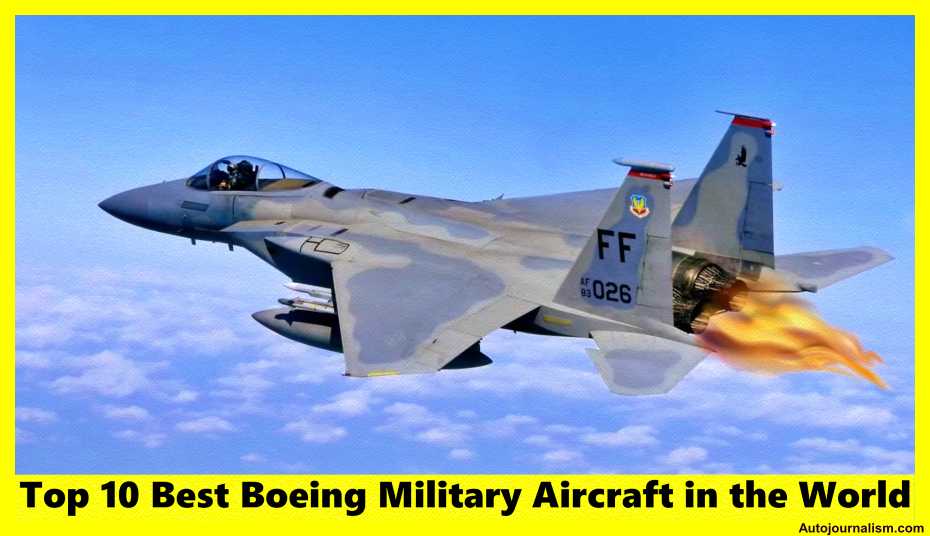Top 10 Weapons Of Israeli Defense Force
Table of Contents
Today we will Share the Updated list of Top 10 Weapons Of Israeli Defense Force and you can Download this Page as a PDF in 1 click, just go to the end of this Page, So let’s Start.
- The Israeli Defense Force (IDF) stands as one of the world’s most technologically advanced military forces, equipped with an array of cutting-edge weaponry designed to ensure the nation’s security in the face of persistent regional challenges. From innovative missile defense systems to state-of-the-art fighter jets, the IDF’s arsenal reflects decades of research, development, and adaptability. In this article, we will explore some of the remarkable weapons that bolster the IDF’s defense capabilities and Top 10 Weapons Of Israeli Defense Force.
Also read: India Journalism
Table of Top 10 Weapons Of Israeli Defense Force
| Rank + Weapon | Description | Countermeasure |
|---|---|---|
| 1. Iron Dome Interceptor System | C-RAM missile system designed to intercept rockets, artillery shells, and mortars aimed at civilians. | Overwhelm the system with a saturation attack, launch decoy missiles to confuse Iron Dome’s sensors, develop faster and stealthier projectiles. (Iron Dome can be Confused with 5000+ Incoming Rockets at a time or Incoming lots of Dummy flares, Try to Hacking, etc.) |
| 2. Merkava 4 Main Battle Tank | Advanced tank with 120mm smoothbore gun, anti-tank missile capabilities, and Trophy Active Protection System. | Use advanced anti-tank missiles or rockets with top-attack capabilities, employ electronic warfare to disrupt Trophy’s sensors. |
| 3. F-15I and F-16I Fighter Jets | State-of-the-art fighter jets with advanced avionics and weaponry, providing Israel with air superiority. | Deploy long-range anti-aircraft missiles with superior tracking and maneuverability, utilize ground-based anti-aircraft systems, employ radar jamming techniques. |
| 4. Protector Unmanned Surface Vehicle (USV) | Unmanned boat equipped for surveillance, investigation, and engagement of hostile targets. | Use anti-ship missiles or torpedoes from naval vessels or aircraft, employ electronic countermeasures to disrupt communication and control signals. |
| 5. Delilah Cruise Missile | Medium-range, subsonic missile known for exceptional accuracy and ability to engage air defense sites. | Implement ground-based air defense systems with advanced radar and surface-to-air missiles, use electronic countermeasures to confuse the missile’s guidance systems. |
| 6. Arrow 3 Anti-Ballistic Missile System | Ballistic missile defense system intercepting threats at altitudes over 100 km, ensuring Israel’s safety. | Develop hypersonic ballistic missiles that can bypass interceptors, utilize maneuverable re-entry vehicles, employ stealth technology to evade radar detection. |
| 7. Tavor and Micro-Tavor Assault Rifles | Bullpup design rifles with enhanced accuracy and maneuverability, standard infantry weaponry of the IDF. | Utilize body armor and cover, employ sniper rifles with longer effective range, engage in guerrilla tactics to minimize exposure. |
| 8. SAR 5 Corvette | Multi-role corvette armed with Phalanx CIWS, torpedo tubes, Harpoon and Barak-8 anti-ship and SAM missiles. | Use stealth aircraft or ships to approach undetected, employ anti-ship missiles with advanced guidance systems, use electronic warfare to disrupt radar and communication systems. |
| 9. ATMOS 2000 Howitzer | Advanced truck-mounted artillery system with 155mm caliber, high automation, and precision support fire capability. | Employ electronic countermeasures to disrupt communication and targeting systems, use precision-guided munitions to neutralize the artillery positions from a distance. |
| 10. Barak 8 Missile | Medium-range surface-to-air missile system developed through Indo-Israeli collaboration, intercepting supersonic cruise missiles. | Utilize stealth aircraft or drones for low-profile attacks, employ electronic countermeasures to confuse missile guidance systems, employ jamming techniques to disrupt radar tracking. |
It’s important to note that the effectiveness of these countermeasures can vary based on the specific circumstances of the engagement, including the terrain, technological advancements, and tactics employed by both the attacker and defender. Countermeasures often require continuous research and development to stay ahead of evolving military technologies.
Top 10 Most Powerful Weapons of The Israeli Military
The Israel Defense Force (IDF) stands as a unique military powerhouse, enmeshed in a seemingly never-ending conflict with its neighbors since its inception. In this turbulent environment, high-quality weapon systems and well-trained military personnel are not just assets but lifelines. While Israel received significant assistance from the United States and Germany, its local defense industry has also played a pivotal role. This article delves into the 10 most powerful weapons possessed by the Israeli military, showcasing their technological prowess and strategic importance.
#1. Iron Dome Interceptor System
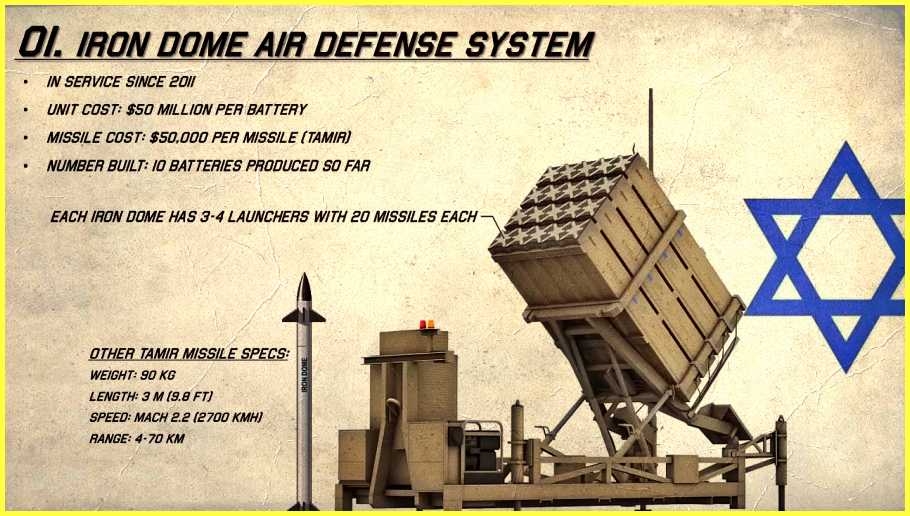
The Iron Dome Interceptor System holds the top spot on this list due to its critical role in protecting Israel from small threats such as rockets, artillery shells, and mortars aimed at civilians. This combat-proven system detects and intercepts rockets directed at populated areas, ensuring civilian safety. Its mobility and efficiency make it a linchpin in Israel’s defense strategy.
Here is a complete table outlining the key details of the Iron Dome Interceptor System:
| Parameter | Details |
|---|---|
| Country of Origin | Israel |
| Manufacturer | Rafael Advanced Defense Systems |
| Type | Missile Defense System |
| Purpose | Intercepting short-range rockets, artillery shells, and mortars aimed at civilians and populated areas |
| Deployment Year | 2011 |
| Detection Range | Approximately 70-150 kilometers (43-93 miles) |
| Interception Range | Up to 70 kilometers (43 miles) |
| Interception Altitude | Up to 32.8 kilometers (20.4 miles) |
| Interceptor Missiles | Tamir interceptor missiles |
| Launcher Capacity | Each launcher truck can carry 20 missiles |
| Components | Launch trucks, Radars, Missile Control Unit |
| Mobility | Mobile, can be quickly deployed to conflict zones |
| Notable Feature | Selectively intercepts rockets aimed at civilian and populated areas |
| Success Rate | High success rate, exact figures are classified |
| Operational Status | Active and deployed in Israel and other regions |
| Cost per Interceptor | Approximately $50,000 to $150,000 per missile (estimated) |
| Variants | Iron Dome 2.0, Iron Dome 3.0 (upgraded versions under development) |
Please note that some specific details, especially recent developments or classified information, might not be included in this table due to the sensitive nature of military technology.
Features of the Iron Dome Interceptor System:
- C-RAM Technology: The Iron Dome is a highly advanced C-RAM (Counter-Rocket Artillery Mortar) missile system developed by the IDF.
- Tamir Interceptor Missile: It utilizes the Tamir interceptor missile, specifically designed to neutralize short-range rockets and artillery shells, with an impressive range of 70 km.
- Protection against Small Threats: Iron Dome is designed to protect Israel from the smallest threats, including rockets, artillery shells, and mortars, often targeted at civilian areas.
- Precision Interception: The system is capable of detecting incoming threats and intercepts only those rockets that pose a risk to civilian populated areas, ensuring precise targeting.
- Cost and Resource Efficiency: Iron Dome’s selective targeting approach saves both money and resources. By intercepting only the 10% of rockets that are accurately aimed, it avoids unnecessary engagements, as the remaining 90% usually fall harmlessly in open areas.
- Mobile Deployment: The Iron Dome system comprises launcher trucks, radars, and a missile control unit, all of which are mobile and can be swiftly deployed to conflict zones as needed.
- Interceptor Missile Capacity: Each launcher truck can carry 20 interceptor missiles, allowing for rapid and continuous response capabilities.
- High Success Rate: Israel claims an impressive interception success rate of 87% for the Iron Dome system, making it one of the most effective modern air defense systems globally.
- Future Enhancements: The Iron Dome system is set to be reinforced further with the integration of the ‘Iron Beam’ laser system and ‘David’s Sling’ missile system by 2018, ensuring comprehensive coverage against all aerial rocket and artillery attacks.
- Worldwide Recognition: Iron Dome is internationally renowned for its combat-proven effectiveness and has garnered widespread attention for its ability to protect civilian populations from incoming threats.
#2. SA’AR 5 Corvette
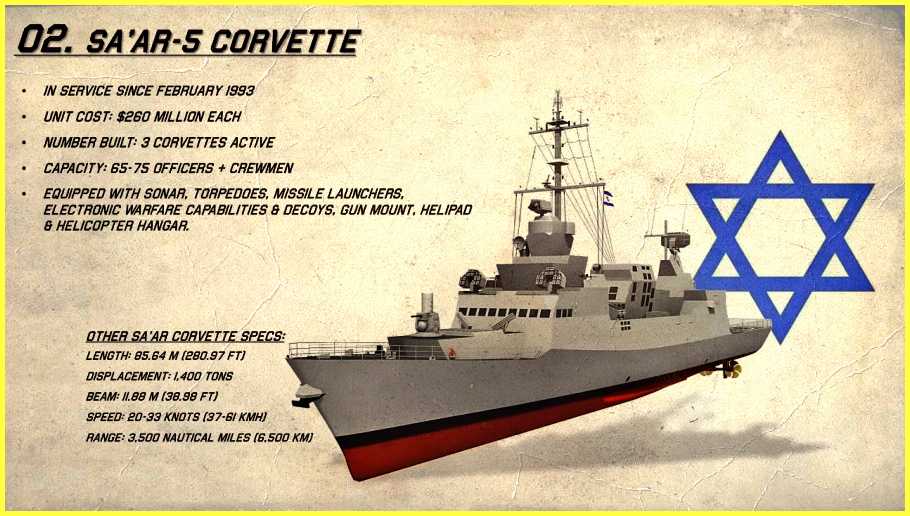
Israel’s coastline, shared with adversaries, necessitates a robust naval force. The SA’AR 5 Corvette fits this bill, armed with torpedo tubes, Harpoon missiles, and surface-to-air missiles. This vessel is a testament to Israel’s maritime strength, deterring potential threats in the Mediterranean and Red Seas.
Here is a complete table outlining the key details of the SA’AR 5 Corvette:
| Parameter | Details |
|---|---|
| Country of Origin | Israel |
| Manufacturer | Israel Shipyards Ltd. |
| Type | Corvette (Naval Vessel) |
| Purpose | Naval Patrol, Anti-Submarine Warfare, Surface Warfare |
| Displacement | Approximately 900 tons |
| Length | Approximately 85 meters (279 feet) |
| Beam | Approximately 12 meters (39 feet) |
| Draft | Approximately 3.2 meters (10.5 feet) |
| Speed | Approximately 30 knots (55.6 km/h or 34.5 mph) |
| Range | Approximately 3,500 nautical miles at 15 knots |
| Crew | Approximately 60-70 personnel |
| Armament | – 2 × 324 mm Torpedo Tubes |
| – 8 × Harpoon Anti-Ship Missiles | |
| – 16 × Barak 8 Surface-to-Air Missiles | |
| – 32 × Barak 1 Surface-to-Air Missiles | |
| Additional Defense | Phalanx Close-In Weapon System (CIWS) |
| Sensors | – Radar Systems for Surveillance and Target Tracking |
| – Sonar Systems for Anti-Submarine Warfare | |
| Electronic Warfare | Electronic Support Measures (ESM) Systems |
| Aircraft Facilities | Helicopter Deck and Hangar for Medium-Size Helicopter |
| Notable Feature | Multi-role capabilities, advanced missile systems, and anti-submarine warfare capabilities |
| Operational Status | Active, in service with the Israeli Navy |
| Year of Introduction | SAR 5 variants have been in service since the 1990s |
| Variants | SAR 5.1 (Original Variant), SAR 5.2 (Upgraded Variant) |
Please note that specific details, especially classified information or recent developments, might not be included in this table due to the sensitive nature of military technology.
Features of Sa’ar 5 Corvette:
- Multi-Role Capabilities: Sa’ar 5 is a versatile corvette designed for Anti-Submarine, Anti-Surface, and Anti-Air warfare, making it highly adaptable to various combat scenarios.
- Compact yet Powerful: Despite its relatively small displacement of around 1100 tons, it possesses the firepower comparable to a much larger 4000-ton frigate, emphasizing its efficiency and combat capability.
- Advanced Radar System: Equipped with a 4 Panel AESA radar, the MF-STAR radar enables the Sa’ar 5 to search, track, and guide up to 16 Barak-8 SAMs simultaneously, enhancing its air defense capabilities significantly.
- Formidable Armament: The corvette is armed with a potent array of weapons, including 1 Phalanx CIWS, 3×2 324 mm torpedo tubes, 8 Harpoon Anti-Ship missiles, 16 Barak-8 Surface-to-Air Missiles (SAM), and 32 Barak-1 SAM, ensuring comprehensive offensive and defensive capabilities.
- Enhanced Self-Defense: The Sa’ar 5 possesses the ability to defend itself against any aerial threat, owing to its sophisticated radar system and a robust anti-aircraft missile arsenal.
- Highly Armed Warship: With an exceptional Weapons-Displacement ratio, the Sa’ar 5 holds the distinction of being one of the most heavily armed ships in the world, showcasing its impressive offensive power relative to its size.
- Operational Versatility: It can operate both in littoral (nearshore) and blue water (open sea) environments, allowing it to respond effectively to threats across various naval terrains.
- Effective Anti-Submarine Warfare: Designed to counter submarines, the Sa’ar 5 is equipped with 324 mm torpedo tubes, enhancing its capabilities in detecting and neutralizing underwater threats.
- Strategic Defense: Given Israel’s valuable coastal assets, the Sa’ar 5 plays a crucial role in defending the country’s interests, including oil wells and other vital resources, from potential threats posed by neighboring nations equipped with advanced anti-ship missiles and submarines.
- Efficiency in Defense: Its ability to efficiently handle multiple types of warfare, combined with its advanced radar technology, makes it an indispensable asset in Israel’s naval defense strategy, ensuring a robust and responsive defense against various naval threats.
#3. Merkava 4M Tank

The Merkava 4M tank, equipped with a 120mm smoothbore gun and advanced secondary armament, showcases Israel’s ground firepower. Unique to this tank is its ability to fire anti-tank missiles from the main gun, providing a tactical advantage. Its Trophy Active Protection System further enhances its defensive capabilities.
Here is a complete table outlining the key details of the Merkava 4M Tank:
| Parameter | Details |
|---|---|
| Country of Origin | Israel |
| Manufacturer | Israel Military Industries (IMI) |
| Type | Main Battle Tank (MBT) |
| Crew | 4 (Commander, Gunner, Loader, Driver) |
| Weight | Approximately 65 tons |
| Length | Approximately 7.6 meters (25 feet) |
| Width | Approximately 3.7 meters (12 feet) |
| Height | Approximately 2.6 meters (8.5 feet) |
| Armor | Composite and Modular, with Advanced Reactive Armor |
| Main Armament | 120 mm Smoothbore Gun with Integrated Anti-Tank Missile Firing Capability |
| Secondary Armament | – 1 × 12.7 mm Machine Gun |
| – 2 × 7.62 mm Machine Guns (coaxial and anti-aircraft) | |
| Additional Armament | – 1 × 60 mm Mortar |
| – 12 × Smoke Grenade Launchers | |
| Engine | 1,500 horsepower, Water-Cooled Diesel Engine |
| Speed | Approximately 64 km/h (40 mph) on roads |
| Operational Range | Approximately 500 km (310 miles) on a single tank of fuel |
| Fuel Capacity | Approximately 1,500 liters (396 gallons) |
| Operational Features | – Trophy Active Protection System (APS) |
| – Advanced Fire Control System | |
| – NBC (Nuclear, Biological, Chemical) Protection System | |
| Crew Protection | Overpressure System for Crew Compartment |
| Variants | Merkava 4M Windbreaker (Equipped with Trophy APS and other enhancements) |
| Year of Introduction | Merkava 4 series introduced in the early 2000s |
| Operational Status | Active, in service with the Israel Defense Forces (IDF) |
| Notable Deployments | Used in various conflicts in the Middle East region |
Please note that specific details, especially classified information or recent developments, might not be included in this table due to the sensitive nature of military technology.
Features of Merkava 3/4 Main Battle Tank (MBT):
- Israeli-Origin Design: The Merkava tanks were purposefully designed in the early 1980s to meet specific Israeli military requirements, ensuring self-sufficiency in tank production within the country.
- Evolutionary Design: The Merkava tank design has evolved over the years, with the Merkava 3 and 4 variants being the most advanced and refined versions, incorporating several improvements and innovations.
- Versatile Armament: The Merkava 4 is armed with a powerful 120 mm smoothbore gun, providing it with a potent and accurate main armament. Additionally, it has the unique capability to fire Anti-Tank missiles such as the ‘Lahat’ from the gun, allowing standoff engagement against enemy tanks from a distance.
- Heavy Secondary Armament: Complementing its main gun, the Merkava 4 features a heavy secondary armament, including a 12.7 mm machine gun, two 7.62 mm machine guns, a 60 mm mortar, and 12 smoke grenades. These are crucial for engaging infantry and concealed threats, especially in urban warfare scenarios.
- Ample Ammunition Storage: The tank is equipped with a combination of 48 shells and missiles, ensuring sustained firepower during engagements. This ample ammunition storage contributes to its operational endurance on the battlefield.
- Trophy Active Protection System: One of the standout features of the Merkava 4 is the ‘Trophy’ Active Protection System. This advanced defense mechanism intercepts incoming projectiles, including Anti-Tank shells and missiles, using a network of tiny radars and hardkill projectile dispensers. It serves as the primary layer of defense, enhancing the tank’s survivability.
- Thick Armor: The Merkava 4 boasts thick armor, providing it with a secondary passive defense layer. The robust armor ensures enhanced protection for the crew and critical components, making the tank resilient against various threats.
- Urban Warfare Capability: The Merkava 4’s armament configuration, including multiple machine guns and a mortar, is specifically suited for urban warfare, enabling it to engage infantry and threats in close-quarters combat effectively.
- Standoff Engagement: With its capability to fire Anti-Tank missiles from a distance, the Merkava 4 can engage enemy tanks from standoff distances, allowing it to maintain a strategic advantage during battles.
- Continued Innovation: The Merkava series continues to showcase Israel’s commitment to military innovation, ensuring that the tank remains a formidable force on the modern battlefield, combining firepower, protection, and maneuverability effectively.
#4. F-15I and F-16I Fighter Jets

Israel’s air superiority is maintained by the F-15I and F-16I fighter jets. These aircraft enable Israel to strike deep inside enemy territories, enhancing its strategic reach. With their potent weapon payloads, these fighter jets are pivotal in maintaining Israel’s aerial dominance.
Here is a complete table outlining the key details of the F-15I and F-16I Fighter Jets used by the Israel Defense Forces (IDF):
| Parameter | F-15I (Ra’am) | F-16I (Sufa) |
|---|---|---|
| Country of Origin | United States | United States |
| Manufacturer | Boeing | Lockheed Martin |
| Type | Air Superiority Fighter | Multirole Fighter-Bomber |
| Role | Air Superiority, Ground Attack | Air-to-Ground and Air-to-Air Combat |
| Crew | 2 (Pilot and Weapons Systems Officer) | 1 (Pilot) |
| Length | Approximately 19.43 meters (63.75 feet) | Approximately 15.06 meters (49.42 feet) |
| Wingspan | Approximately 13.05 meters (42.8 feet) | Approximately 9.96 meters (32.6 feet) |
| Height | Approximately 5.63 meters (18.47 feet) | Approximately 5.09 meters (16.7 feet) |
| Empty Weight | Approximately 14,700 kg (32,500 lbs) | Approximately 9,207 kg (20,300 lbs) |
| Maximum Takeoff Weight | Approximately 36,740 kg (81,000 lbs) | Approximately 19,187 kg (42,300 lbs) |
| Maximum Speed | Mach 2.5 (3,174 km/h or 1,975 mph) | Mach 2+ (2,414 km/h or 1,500 mph) |
| Combat Radius | Approximately 1,400 km (870 miles) | Approximately 550 km (342 miles) |
| Ferry Range | Approximately 4,700 km (2,920 miles) | Approximately 4,220 km (2,620 miles) |
| Armament | – 20 mm M61 Vulcan Gatling Gun | – 20 mm M61 Vulcan Gatling Gun |
| – Air-to-Air and Air-to-Ground Missiles | – Air-to-Air and Air-to-Ground Missiles | |
| – Bombs, Rocket Pods, Electronic Warfare Systems | – Bombs, Rocket Pods, Electronic Warfare Systems | |
| Notable Features | – Advanced Avionics and Radar Systems | – Advanced Avionics and Radar Systems |
| – Long-Range Capabilities | – Multirole Capabilities | |
| Operational Status | Active, in service with the Israel Air Force (IAF) | Active, in service with the Israel Air Force (IAF) |
| Variants | F-15I (Israeli Variant of F-15E Strike Eagle) | F-16I (Israeli Variant of F-16D Block 52+) |
| Operational History | Used in various military operations, including the | Used in various military operations, including the |
| bombing of nuclear reactors in Iraq and Syria | bombing of nuclear reactors in Iraq and Syria |
Please note that specific details, especially classified information or recent developments, might not be included in this table due to the sensitive nature of military technology.
#5. Protector Unmanned Surface Vehicle (USV)
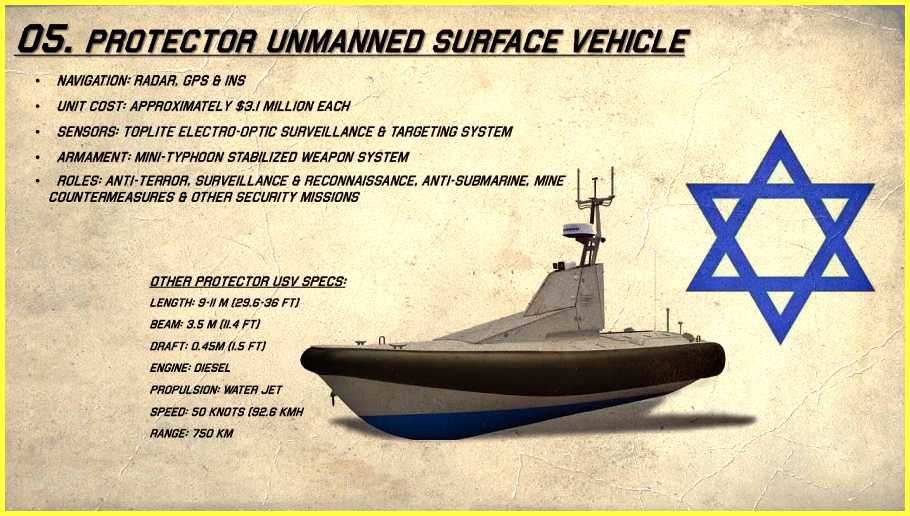
Israel pioneered the use of armed Seaborn drones for surveillance missions, a testament to its innovation. The Protector USV, armed with machine guns and grenade launchers, patrols harbors, conducts anti-piracy duties, and engages hostile small craft, bolstering Israel’s naval defenses.
Here is a complete table outlining the key details of the Protector Unmanned Surface Vehicle (USV) used by the Israel Defense Forces (IDF):
| Parameter | Details |
|---|---|
| Country of Origin | Israel |
| Manufacturer | Rafael Advanced Defense Systems |
| Type | Unmanned Surface Vehicle (USV) |
| Purpose | Surveillance, Reconnaissance, Anti-Submarine Warfare, |
| Mine Countermeasures, Harbor Patrol, Interception | |
| Length | Approximately 9 meters (29.5 feet) |
| Beam | Approximately 2.5 meters (8.2 feet) |
| Displacement | Approximately 12 tons |
| Speed | Over 90 km/h (approximately 55.9 mph) |
| Endurance | More than 40 hours at economical speeds |
| Armament | – Typhoon Remote Weapon System |
| – Machine Gun and Grenade Launcher (Optional) | |
| Missile System | Spike Fire-and-Forget Missile System (Optional) |
| Operational Range | Beyond Line-of-Sight (BLOS) control up to 100 km |
| Crew | Typically remotely operated by two operators |
| Sensors | Electro-Optical and Infrared (EO/IR) Cameras |
| Radar Systems for Surveillance | |
| Additional Features | – High-Speed Maneuverability |
| – Automated Collision Avoidance | |
| – Long-Range Communication Systems | |
| – Modular Payload Bay for Customization | |
| Operational Status | Active, in service with the Israeli Navy |
| Notable Deployments | Used for surveillance missions within and around Israeli territory, harbor patrols, anti-piracy operations, and more |
Please note that specific details, especially classified information or recent developments, might not be included in this table due to the sensitive nature of military technology.
Features of Protector Unmanned Surface Vehicle (USV):
- Innovative Unmanned Design: The Protector USV represents cutting-edge technology as the world’s first armed unmanned boat, designed and deployed by Israel for surveillance and protection duties.
- Minimal Operator Requirement: Unlike manned patrol boats, the Protector USV operates efficiently with just 2 operators, who control the vessel from a secure control station located away from hostile areas. This streamlined crew requirement significantly reduces manpower and enhances operational efficiency.
- Increased Endurance: Compared to manned boats, the Protector’s reduced crew and increased fuel storage capacity lead to significantly enhanced operational endurance, lasting more than four times longer on missions.
- Versatile Sensor Suite: The USV is equipped with an array of sensors, including electro-optical sensors and radar, enabling comprehensive surveillance, reconnaissance, and threat detection capabilities.
- Stabilized Remote Weapons Station: The Protector is armed with a Typhoon stabilized remote weapons station, which can be fitted with various weapons, including machine guns and grenade launchers. This armament enhances the vessel’s defensive capabilities.
- Anti-Piracy Operations: With a remarkable speed of 50 knots (92 km/hr.), the Protector is highly effective in anti-piracy operations. Its speed, combined with a wide range of sensors, allows it to track and chase pirate boats efficiently, making it an invaluable asset in maritime security.
- Enhanced Maneuverability: The USV’s unmanned nature allows for agile and precise maneuvers, ensuring quick responses to changing operational requirements and threats.
- Deployable for Surveillance: The Protector USV is deployed around harbors for surveillance, investigation, and engagement of hostile small craft. Its advanced sensor suite ensures accurate threat assessment and targeted responses.
- Customization for Specific Missions: The 11 m variant of the Protector can be fitted with Spike missiles and a water cannon for non-lethal engagements and firefighting, enhancing its versatility for various mission profiles.
- International Deployment: Countries like Singapore have recognized the USV’s capabilities and deployed Protectors for surveillance, reconnaissance, and force protection duties in regions like the Persian Gulf, showcasing its reliability and effectiveness in real-world scenarios.
- Continued Advancements: The Protector USV serves as a pioneering model for unmanned maritime technology, paving the way for the development of larger, more advanced unmanned vessels in the future, marking a significant advancement in naval capabilities.
#6. ATMOS 2000 Howitzer
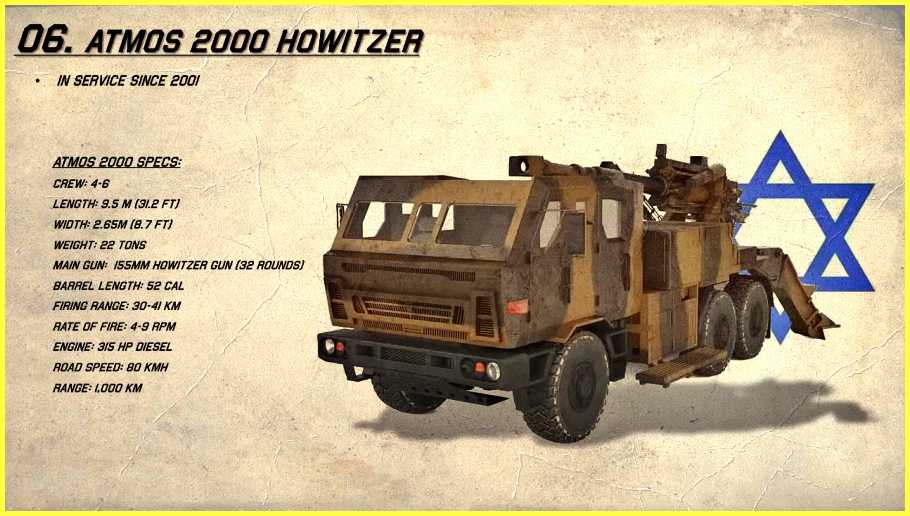
The ATMOS 2000 Howitzer is a cutting-edge, truck-mounted artillery system. Its mobility, precision, and automation, combined with aerial data integration, allow for rapid deployment and accurate support fire. This self-propelled artillery weapon is a force multiplier for the IDF.
Here is a complete table outlining the key details of the ATMOS 2000 (Autonomous Truck Mounted Howitzer System) used by the Israel Defense Forces (IDF):
| Parameter | Details |
|---|---|
| Country of Origin | Israel |
| Manufacturer | Soltam Systems (now Elbit Systems) |
| Type | Self-Propelled Howitzer |
| Caliber | 155 mm |
| Barrel Length | 52 calibers (8.06 meters or 26.44 feet) |
| Maximum Range | Approximately 41-41.5 km (25.47-25.78 miles) |
| Rate of Fire | 4 to 9 rounds per minute (depending on crew) |
| Projectile Types | Various, including High-Explosive, Illumination, |
| Smoke, Extended-Range Guided Munitions | |
| Crew | 4 (Commander, Gunner, Loader, Driver) |
| Mobility | Mounted on a 6×6 or 8×8 truck for high mobility |
| Automated Systems | Touch screen computer for precise firing solutions |
| Protection | Crew compartment protection against small arms fire |
| Operational Status | Active, in service with the Israel Defense Forces (IDF) |
| Notable Feature | Advanced automation for precise firing, rapid deployment capability, mobility, and interoperability with other artillery systems |
Please note that specific details, especially classified information or recent developments, might not be included in this table due to the sensitive nature of military technology.
Features of ATMOS 2000 Howitzer:
- Self-Propelled Artillery: ATMOS 2000 is a cutting-edge 155 mm 52 caliber self-propelled artillery system mounted on a 6×6 truck, providing excellent mobility and rapid response capabilities on the battlefield.
- Minimal Crew Requirement: Operated by a crew of just 4 men, the system’s high degree of automation and extensive use of computers allow for efficient operation and reduced manpower, enhancing tactical flexibility.
- Advanced Fire Control: Equipped with a touchscreen computer, the system can calculate precise firing solutions, ensuring accurate targeting. It integrates data from aerial assets such as UAVs, enabling the delivery of precision support fire to ground troops.
- High Rate of Fire: The ATMOS 2000 can fire 155 mm shells at a rapid rate, ranging from 4 to 9 rounds per minute, based on the specific operational requirements and crew reloading capacity.
- Onboard Ammunition Capacity: With the ability to carry 32 rounds of 155 mm shells onboard, the system ensures sustained firepower during extended engagements, contributing to prolonged operational effectiveness.
- Aerial Transportability: Designed to be transported by aircraft like the C-130, the ATMOS 2000 offers rapid deployment capabilities, allowing it to be swiftly transported to hostile areas, ensuring timely response to emerging threats.
- Precision Support Fire: Integrating data from aerial assets enables the system to provide precision support fire to ground troops. This capability significantly enhances the accuracy and effectiveness of artillery strikes on targets.
- Strategic Mobility: Mounted on a 6×6 truck, the ATMOS 2000 combines firepower with strategic mobility, making it well-suited for rapid maneuverability across diverse terrains, ensuring adaptable and responsive artillery support.
- Operational Flexibility: With its advanced technology and rapid deployment capabilities, the ATMOS 2000 enhances the IDF’s operational flexibility, allowing for quick repositioning and engagement of targets in various battlefield scenarios.
- Modern Warfare Adaptability: Designed to meet the demands of modern warfare, the ATMOS 2000 Howitzer represents a fusion of mobility, precision, and firepower, making it a valuable asset for the IDF’s artillery corps in contemporary military operations.
#7. Tavor X95 Assault Rifle
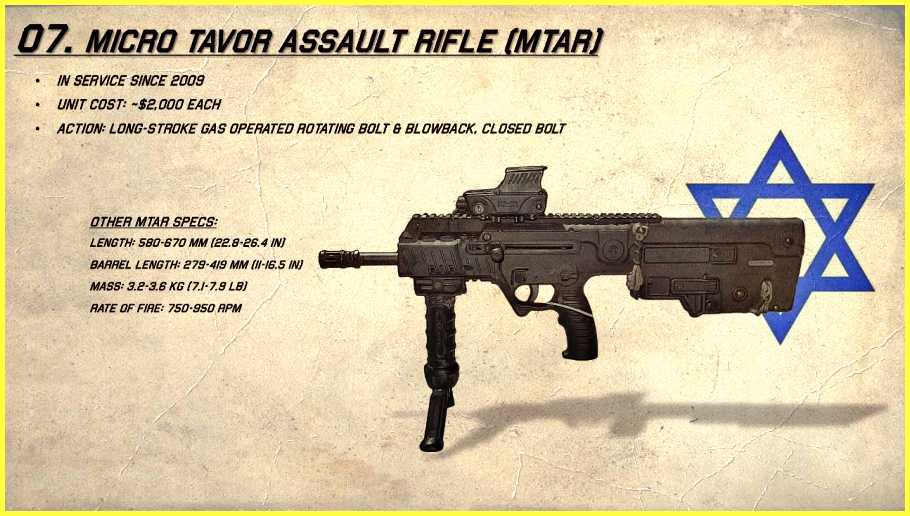
The Tavor X95 Assault Rifle, designed for reliability and accuracy, represents the future of infantry weaponry. Its compact design and variants tailored for specific needs, including Special Forces use, make it a versatile choice for the IDF’s ground forces.
Here is a complete table outlining the key details of the Tavor X95 Assault Rifle used by the Israel Defense Forces (IDF):
| Parameter | Details |
|---|---|
| Country of Origin | Israel |
| Manufacturer | Israel Weapon Industries (IWI) |
| Type | Bullpup Assault Rifle |
| Caliber | 5.56×45mm NATO |
| Action | Gas-operated, rotating bolt |
| Effective Range | Approximately 500 meters (1,640 feet) |
| Rate of Fire | 700–950 rounds per minute |
| Magazine Capacity | Standard: 30 rounds (Detachable box magazine) |
| Variants | – X95 (Standard variant) |
| – Micro Tavor (Compact variant) | |
| Sights | Integrated Picatinny rails for various optics and sights |
| Barrel Length | 330 mm (13 inches) for standard barrel |
| Weight | Approximately 3.6 kg (7.9 lbs) with loaded magazine |
| Length | 580 mm (22.8 inches) with standard barrel |
| Additional Features | – Ambidextrous design (ejection port and charging handle) |
| – Short-stroke gas piston system | |
| – Bullpup design for compactness | |
| Notable Feature | Futuristic design, compact size, high reliability, and adaptability to various combat situations |
| Operational Status | Active, in service with the Israel Defense Forces (IDF) |
Please note that specific details, especially classified information or recent developments, might not be included in this table due to the sensitive nature of military technology.
Features of Tavor and Micro-Tavor Assault Rifles:
- Bullpup Design: The Tavor and Micro-Tavor assault rifles feature a futuristic bullpup design, providing a compact and maneuverable form factor without compromising barrel length.
- Lightweight Construction: Designed to be lighter than the M4A1 carbine, these rifles prioritize mobility, making them suitable for various combat scenarios, including urban warfare and close-quarters engagements.
- Reliability and Durability: Engineered for reliability and durability, these rifles are built to withstand rigorous military use, ensuring consistent performance in challenging environments.
- Improved Accuracy: The Tavor series is crafted for enhanced accuracy, offering precise aiming and effective target engagement, contributing to the shooter’s overall effectiveness on the battlefield.
- Caliber Variants: Available in different calibers, including the standard 5.56×45 NATO round, these rifles offer flexibility in ammunition selection, catering to specific mission requirements.
- Suffix 21 Designation: The suffix “21” (TAR-21) signifies that these rifles are designed for the 21st century, incorporating modern features and technology to meet contemporary military demands.
- Versatile Variants: The rifle series includes various variants tailored for specific roles:
- GTAR: A conventional variant designed to accommodate a 40 mm Underbarrel Grenade Launcher (UBGL).
- MTAR: A micro variant, extremely compact in size, specifically designed for special forces, offering enhanced maneuverability in tight spaces.
- STAR: A marksman variant equipped with a bipod and a 4x magnification ACOG sight, optimized for precision shooting.
- Reflex Sight: All variants come equipped with a reflex sight, providing a clear red aiming point for improved target acquisition and rapid aiming in combat situations.
- International Adoption: These rifles have been extensively used by the IDF infantry units and have also been adopted by international forces. For example, the Indian Army commandos utilize the MTAR-21 variant, known locally as Zittara, chambered in 5.56×30 mm cartridge.
- Exceptional Performance: Renowned for their outstanding combat performance, particularly in hot desert climates, these rifles have proven their effectiveness and reliability in challenging operational environments, earning the trust of military professionals worldwide.
#8. Delilah Cruise Missile
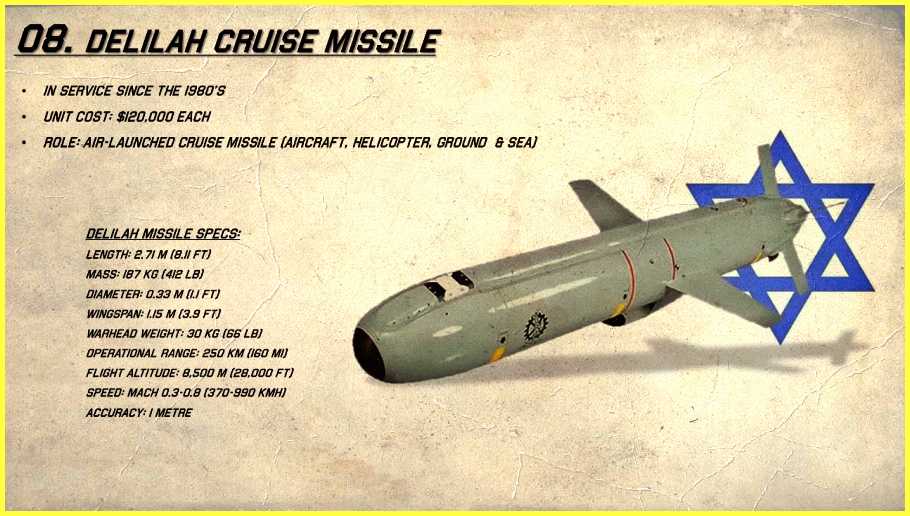
The Delilah Cruise Missile stands out for its remarkable precision and versatility. Launched from fighter jets and helicopters, it can loiter near targets, allowing remote navigators to strike with pinpoint accuracy. Its ability to destroy enemy air defense sites and moving vehicles makes it a formidable asset.
Here is a complete table outlining the key details of the Delilah Cruise Missile used by the Israel Defense Forces (IDF):
| Parameter | Details |
|---|---|
| Country of Origin | Israel |
| Manufacturer | Israel Aerospace Industries (IAI) |
| Type | Air-Launched Cruise Missile |
| Warhead | Approximately 30 kg (66 lbs) |
| Range | 250 km (155 miles) |
| Speed | Subsonic (approximately Mach 0.3 to 0.7) |
| Guidance System | Inertial Navigation System, GPS, Infrared and Optical Sensors |
| Accuracy | Precise targeting, with a margin of error within 1 meter |
| Launch Platforms | – F-15 Fighter Jets |
| – F-16 Fighter Jets | |
| – AH-64 Apache Helicopters (Ground-Launched Variant) | |
| Operational Range | Low altitude, terrain-hugging flight for stealth and evasion |
| Mission Profiles | – Precision Strikes against Enemy Air Defenses |
| – Targeting Enemy Radar Installations | |
| – Neutralizing Surface-to-Air Missile Systems | |
| Notable Feature | Ability to loiter near the target, allowing remote navigator to identify and strike the target at an appropriate time |
| Operational Status | Active, in service with the Israel Defense Forces (IDF) |
Please note that specific details, especially classified information or recent developments, might not be included in this table due to the sensitive nature of military technology.
Features of Delilah Cruise Missile:
- Medium-Range Subsonic Missile: Delilah is a medium-range subsonic cruise missile developed by the IDF, resembling a mini Tomahawk missile, capable of engaging targets at significant distances.
- Exceptionally Light and Compact: Despite its 250 km range, Delilah is remarkably lightweight at 187 kg, making it compact and enabling launch from various platforms, including F-15/16 fighter jets and UH-60 helicopters.
- Versatile Launch Platforms: Delilah can be effectively launched from aircraft such as F-15/16 and helicopters like the UH-60, showcasing its adaptability to different aerial platforms for versatile mission profiles.
- Speed and Accuracy: The missile travels at a speed ranging from Mach 0.3 to 0.7, ensuring rapid target engagement. Its accuracy is impressive, with a 1-meter error margin, making it suitable for precision strikes against specific targets, including enemy air defense sites.
- Loitering Capability: Delilah’s unique feature is its ability to loiter around the target area, allowing a remote navigator to utilize infrared (IR) and optical sensors to identify the target accurately. This ensures optimal timing for striking the target effectively.
- Ground-Launched Variant: In addition to aerial deployment, Delilah also has a ground-launched variant with the same 250 km range, expanding its operational flexibility and options for deployment.
- Target Variety: Designed for versatility, Delilah can effectively engage smaller targets such as SAM (Surface-to-Air Missile) sites and moving vehicles, making it a valuable asset in tactical military operations.
- Long Range: With its impressive 250 km range, Delilah can engage targets located at considerable distances, providing the IDF with a strategic advantage in various operational scenarios.
- Pinpoint Accuracy: Delilah’s ability to strike targets with a 1-meter error margin ensures precise targeting, making it suitable for missions where accuracy is paramount, such as disabling enemy air defenses.
- Lethal Combination: The combination of lightweight construction, long range, and pinpoint accuracy makes Delilah a highly lethal weapon, capable of striking high-value and well-protected targets with exceptional effectiveness.
#9. Barak 8 Missile

Developed through Indo-Israeli collaboration, the Barak 8 Missile is designed to intercept supersonic cruise missiles. Its dual-pulse rocket motor and long-range variants provide Israel with a robust defense against aerial threats, both in the Navy and Air Force.
Here is a complete table outlining the key details of the Barak 8 Missile used by the Israel Defense Forces (IDF) and developed through an Indo-Israeli collaboration:
| Parameter | Details |
|---|---|
| Country of Origin | Israel and India |
| Manufacturer | Israel Aerospace Industries (IAI) and Defense Research and Development Organization (DRDO, India) |
| Type | Long-Range Surface-to-Air Missile |
| Role | Anti-Aircraft and Anti-Missile Defense |
| Warhead Weight | Approximately 60 kg (132 lbs) |
| Range | 70-120 km (43-75 miles) |
| Speed | Supersonic (Mach 2) |
| Guidance System | Active Radar Homing with Inertial Navigation System |
| Engagement Altitude | Up to 16 km (52,500 feet) |
| Radars Used | MFSTAR (Multi-Function Surveillance, Track And Guidance Radar) |
| Variants | – Barak 8 Naval Variant: Launched from naval vessels |
| – Barak 8 Ground Variant: Launched from mobile launchers | |
| Propulsion System | Dual-Pulse Rocket Motor for Extended Range |
| Operational Status | Active, in service with the Indian Navy and the Israel Navy |
| Notable Feature | – Dual-Pulse Rocket Motor for Extended Range |
| – Vertical Launch from Naval Vessels | |
| – Highly Maneuverable with Advanced Guidance Systems | |
| – Ability to engage multiple targets simultaneously |
Please note that specific details, especially classified information or recent developments, might not be included in this table due to the sensitive nature of military technology.
#10. Arrow 3 Anti-Ballistic Missile System
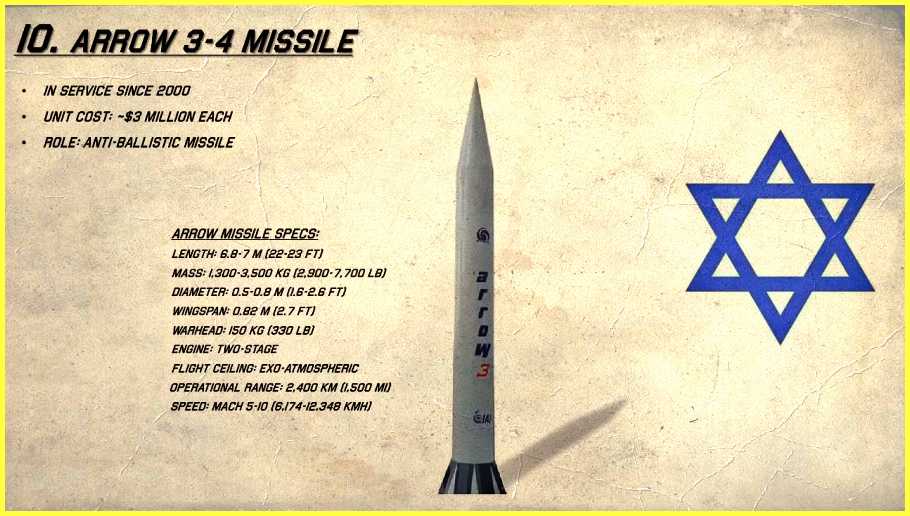
The Arrow 3 Anti-Ballistic Missile System is Israel’s ultimate defense against ballistic missiles. With the capability to intercept missiles at high altitudes, it ensures Israel’s survival by neutralizing threats from adversaries. Its speed, precision, and rapid deployment capabilities make it a vital component of Israel’s missile defense strategy.
Here is a complete table outlining the key details of the Arrow 3 Anti-Ballistic Missile System used by the Israel Defense Forces (IDF):
| Parameter | Details |
|---|---|
| Country of Origin | Israel |
| Manufacturer | Israel Aerospace Industries (IAI) and Boeing (U.S.) |
| Type | Anti-Ballistic Missile System |
| Role | Ballistic Missile Defense |
| Interception Altitude | More than 100 km (328,000 feet) |
| Interception Range | Exo-atmospheric and Endo-atmospheric, beyond 2,000 km (1,243 miles) range for enemy missiles |
| Speed | Hypersonic (Mach 10+) |
| Guidance System | Active Radar Homing, Inertial Navigation System |
| Warhead Type | Hit-to-Kill Kinetic Energy Interceptor |
| Deployment Type | Ground-Based, Mobile Launchers |
| Number of Stages | Three Stages (Booster, Interceptor, Kill Vehicle) |
| Radar Systems | – Elta Green Pine (early warning radar) |
| – Citron Tree (fire control radar) | |
| Operational Range | Long-range capability, capable of intercepting ballistic missiles outside Earth’s atmosphere |
| Crew | Operated remotely and autonomously |
| Notable Features | – Ability to intercept multiple ballistic missiles simultaneously |
| – High-altitude, exo-atmospheric interception capability | |
| – Advanced hit-to-kill technology for precise interceptions | |
| Operational Status | Active, operational with the Israel Defense Forces (IDF) |
| Variants | Arrow 3 Block I, Arrow 3 Block II (upgraded versions under development) |
Please note that specific details, especially classified information or recent developments, might not be included in this table due to the sensitive nature of military technology.
Features of Arrow 3 Anti-Ballistic Missile System:
- High-Altitude Interception: Arrow 3 ABM system is designed to intercept ballistic missiles at altitudes exceeding 100 km, providing Israel with a robust defense against long-range missile threats.
- Enhanced Effectiveness: Developed to be more effective than the renowned American MIM-104 Patriot ABM system, Arrow 3 ensures a higher level of interception accuracy and reliability, making it a vital component of Israel’s defense strategy.
- Integrated Radar System: Integrated with the ‘Green Pine’ radar, Arrow 3 receives precise target information. The Green Pine radar boasts an impressive search and track range of around 400 km, effectively covering the entire airspace of Israel.
- Rapid Multiple Interceptions: A battery of Arrow 3 missiles is capable of intercepting up to 5 ballistic missiles in just 30 seconds, showcasing its rapid response and multiple-target engagement capabilities.
- Smaller Size and Weight: Arrow 3 features a smaller size and a 40% reduction in weight compared to its predecessor, Arrow 2, ensuring greater maneuverability and ease of deployment.
- Strategic Defense: Crucial for Israel’s survival, the Arrow 3 system protects the country from a wide range of ballistic missiles possessed by hostile neighbors, serving as a key component of Israel’s national security.
- Anti-Satellite Capabilities: There are indications that the Arrow 3 system can be utilized as an Anti-Satellite system, similar to the US SM-3 missile, showcasing its versatility in countering both aerial and space-based threats.
- Quick Deployment: The system’s readiness for deployment is enhanced by the 6-cell Arrow-3 Launcher, ensuring rapid and efficient response in the event of missile threats.
- Advanced Technology: Incorporating cutting-edge technology, Arrow 3 employs advanced sensors, precision guidance systems, and high-speed interceptors to neutralize incoming ballistic missiles, making it one of the most technologically advanced anti-ballistic missile systems in the world.
- Critical National Defense: With the capability to intercept long-range missiles, Arrow 3 plays a critical role in safeguarding Israel’s population centers, military assets, and critical infrastructure, reinforcing the country’s defense against potential missile attacks.
Conclusion:
- Israel’s military strength lies not only in its collaborations with allies but also in its indigenous innovation and adaptation. The IDF’s possession of these powerful weapons underscores Israel’s commitment to safeguarding its citizens and maintaining regional stability. As the geopolitical landscape evolves, Israel’s arsenal continues to stand as a testament to its technological prowess and strategic acumen, ensuring its preparedness in the face of any threat.
- Israel’s commitment to military innovation and adaptation continues to shape its formidable defense capabilities. As geopolitical challenges evolve, the IDF’s arsenal remains at the forefront of technology, ensuring the nation’s security and safeguarding its citizens against potential threats.
Also Read:

